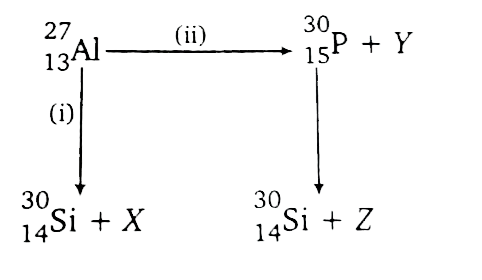Complete Solutions to Exercise-3 of chapter NUCLEAR CHEMISTRY of Class 12 book with complete answers and questions
| Class 12 | CHEMISTRY |
| Chapter | NUCLEAR CHEMISTRY |
| RESONANCE | Exercise-3 |
| Number Of Questions | 15 |
| Academic Year | 2023-24 |
Calculated the energy required to excite one litre of hydrogen gas at `1atm` and `298K` to the first excited state of atomic hydorgen. The enegry for the dissociation of `H-H` bond is `436 kJ mol^(-1)`.
08:12View SolutionThe orbit having Bohr radius equal to 1st Bohr orbit of H-atom is :
02:09View Solution(a) The wave function of an electron in `2s` orbital in hydrogen atom is given below:
`psi_(2s)=1/(4(2pi)^(1//2))(z/a_(0))^(3//2)(2-r/a_(0))exp(-r//2a_(0))`
where `a_(0)` is the radius. This wave function has a radial node at `r=r_(0)`. Express `r_(0)` in terms of `a_(0)`.
(b) Calculate the wavelength of a ball of mass `100 g` moving with a velocity of `100 ms^(-1)`.
(c) `_(92)X.^(238)underset(-6beta)overset(-8alpha)(rarr) Y`. Find out atomic number, mass number of `Y` and identify it.View Solutiona.Calculate the velocity of an electron in the first Bohr's orbit of hydrogen atom (given `r = a_(0))`.
b. Find de Broglie's wavelength of the electron in the first Bohr's orbit.
c. Find the orbital angular momentum of `2p` orbital in terms of `h//2pi` units.04:09View SolutionThe hydrogen -like species `Li^(2+)` is in a spherically symmetric state `S_(1)` with one node. Upon absorbing light , the ion undergoes transition to a state `S_(2)`. The state `S_(2)` has one radial node and its energy is equal is to the ground state energy of the hydrogen atom.
The orbital angular momentum quantum number of the state `S_(2)` is05:26View SolutionThe hydrogen -like species `Li^(2+)` is in a spherically symmetric state `S_(1)` with one node. Upon absorbing light , the ion undergoes transition to a state `S_(2)`. The state `S_(2)` has one radial node and its energy is equal is to the ground state energy of the hydrogen atom.
Energy of the state `S_(1)` in units of the hydrogen atom ground state energy is05:26View SolutionThe hydrogen -like species `Li^(2+)` is in a spherically symmetric state `S_(1)` with one node. Upon absorbing light , the ion undergoes transition to a state `S_(2)`. The state `S_(2)` has one radial node and its energy is equal is to the ground state energy of the hydrogen atom.
The orbital angular momentum quantum number of the state `S_(2)` is05:26View SolutionThe work function `(phi)` of some metals is listed below. The number of metals which will show photoelectric effect when light of `300` nm wavelength falls on the metal is
`((Me t a l ,Li, Na , K , Mg, Cu, Ag , Fe , Pt, W),( phi(eV), 2.4, 2.3, 2.2, 3.7, 4.8, 4.3, 4.7, 6.3, 4.75))`02:02View SolutionThe maximum number of electrons that can have principal quantum number, n = 3, and spin quantum number `m_(s)` = - 1 /2, is
01:26View SolutionBombardment of aluminium by `alpha-"particle"` leads to its artificial disintegration in two ways, `(i) and (ii)` as shown.
Products `X,Y` and `Z` respectively, are
 03:20View Solution
03:20View SolutionThe kinetic energy of an electron in the second Bohr orbit of a hydrogen atom is [`a_0` is Bohr radius] :
03:30View SolutionThe periodic table consists of 18 groups. An isotope of copper, on bombardment with protons, undergoes a nuclear reaction yielding element `X` as shown below. To which group, element `X` belongs in the periodic table ?
`._(29)Cu^(63)+._(1)H^(1)rarr6._(0)n^(1)+._(2)He^(4)(alpha)+2._(1)H^(1)+._(Z)X^(A)`02:30View SolutionIn the nuclear transmutation :
`._(4)^(9) Be + X rarr _(4) ^(8) Be +Y`
(X,Y) is (are)02:17View SolutionIn an atom, the total number of electrons having quantum numbers
`n = 4,|m_(l)| = 1` and `m_(s) =- (1)/(2)` is04:08View SolutionNot considering the electronic spin, the degeneracy of the second excited state `(n = 3)` of H-atom is 9, while the degeneracy of the second excited state of `H^(-)` is
01:36View Solution
Exercise-3 questions and complete solutions for chapter NUCLEAR CHEMISTRY of PHYSICAL, INORGANIC, AND ORGANIC CHEMISTRY of Class 12
All Exercises from RESONANCE Class 12 CHEMISTRY NUCLEAR CHEMISTRY
- ADVANCED LEVEL PROBLEMS
- Board Level Exercise
- Exercise-1
- Exercise-2
- Exercise-20
- Exercise-21
- Exercise-22
- Exercise-23
- Exercise-24
- Exercise-25
- Exercise-26
- Exercise-27
- Exercise-28
- Exercise-29
- Exercise-3
- MISCELLANEOUS SOLVED PROBLEMS (MSPs)
- PART -II
- PART -II : SINGLE AND DOUBLE VALUE INTEGER TYPE
- PART -III :
- PART-II
- PART-II SECTION-1
- PART-III
- PART-IV : COMPREHENSION
- Solved Example
- STAGE-II
